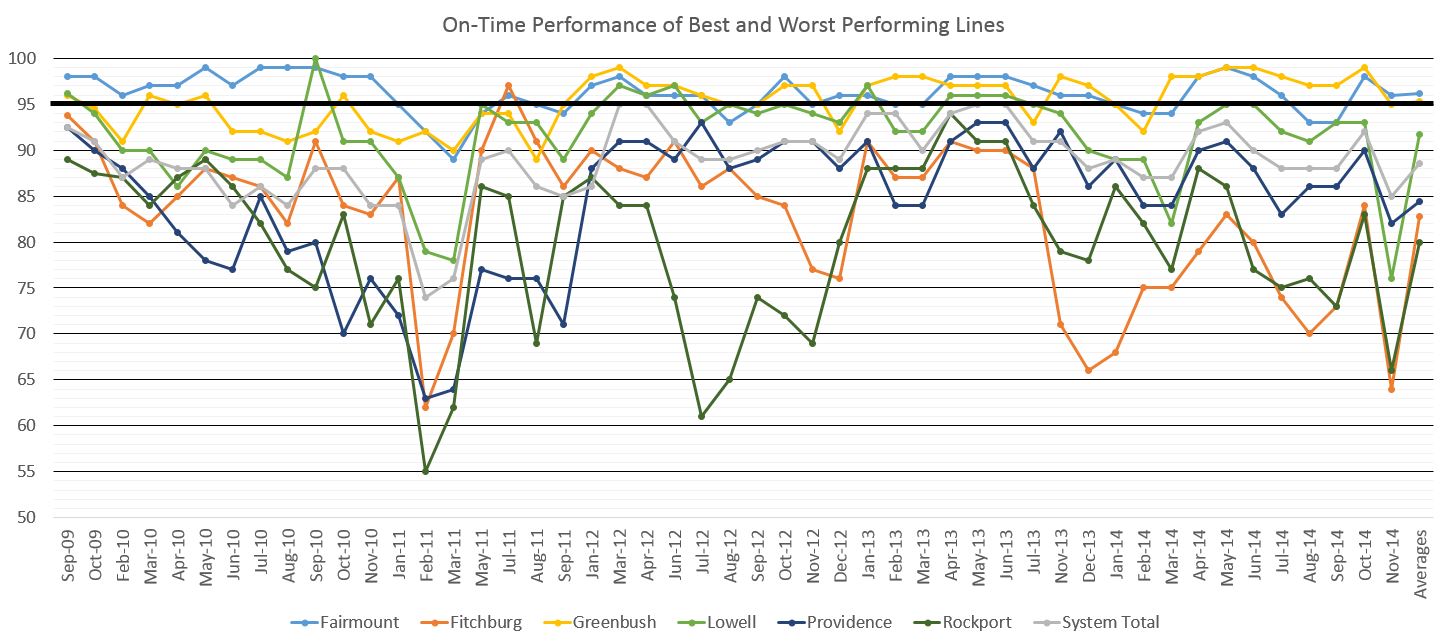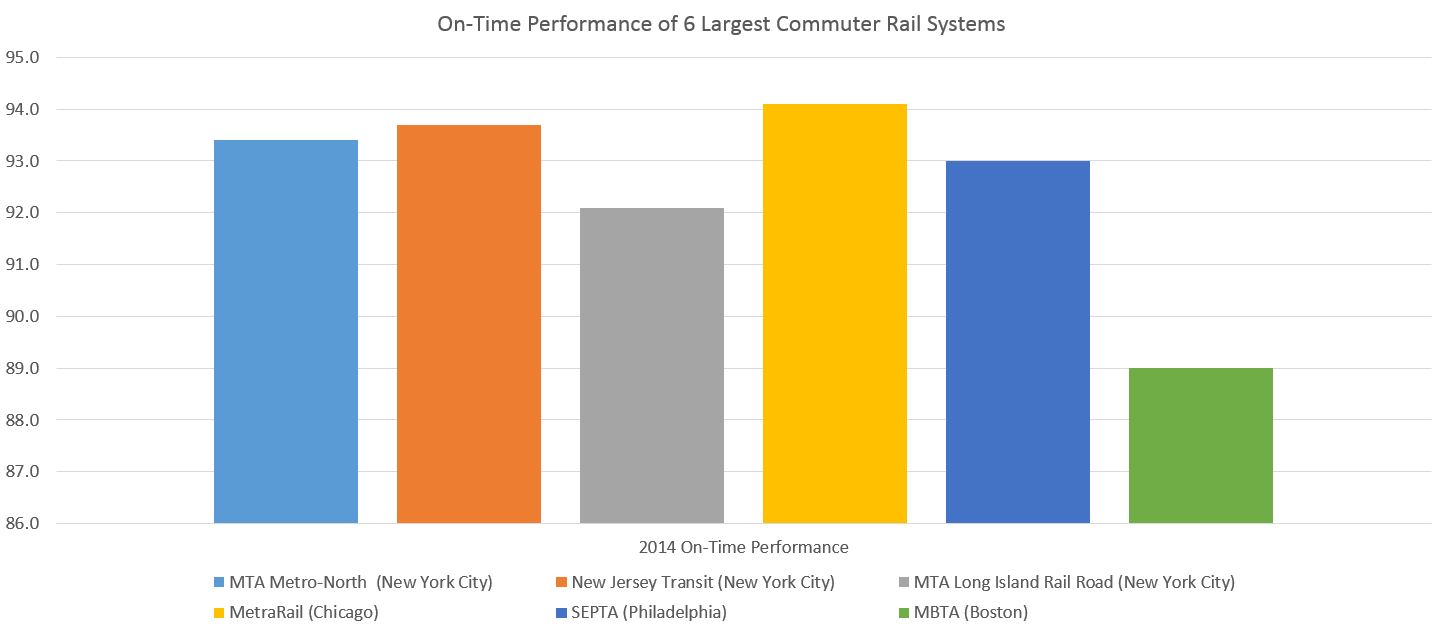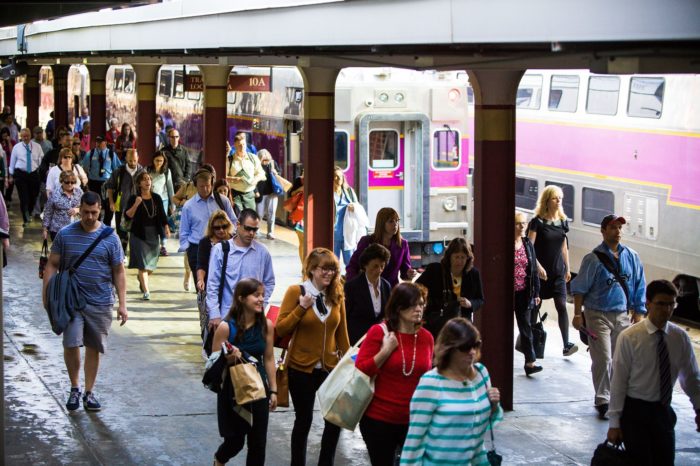MBTA Commuter Rail: New Boss, Same Problems
We all know that the MBTA’s commuter rail trains can be late, but how late are they? Pioneer Institute looked into how the MBTA’s performance stacks up against other major commuter rail systems in the country, and the results are not pretty. Of the ten largest commuter rail systems in the country by ridership the MBTA consistently performs the worst.
A train is considered on-time if it arrives within five minutes of its scheduled arrival time. The reliability of a commuter system’s timeliness is critical to public confidence, making on-time performance the most important measure of operational success. As the sixth biggest commuter rail system the MBTA serves approximately 130,000 people daily and millions per year, and yet it is the largest commuter rail system in the country with an on-time performance below 90 percent.
In only two months since the MBTA began publishing its ScoreCards in late 2009 has the system’s overall on-time percentage met its goal of 95 percent. Even the best performing lines (Fairmount, Greenbush and Lowell) often don’t meet their goals, while the worst performing lines (Fitchburg, Providence and Rockport) have cumulatively met the goal only one time.

In 2014 the MBTA averaged an on-time performance of just 89 percent. This means that on an average day more than 14,000 passengers are inconvenienced by late trains. The Rockport line averaged an on-time performance of 80 percent, meaning that one in five trains were late to their destination. With figures like these it’s no wonder that the commuter rail remains the only service under the MBTA’s jurisdiction with a shrinking ridership, a development contrary to local and national public transportation trends. Public opinion shows that more people would ride the commuter rail to work if it was more reliable, but the MBTA has yet to make progress over the past few years, despite growing efforts.

These are the top six commuter rail systems by annual train miles and ridership. SEPTA’s data is from 2013; the most current data for the next biggest systems is from 2013 or before
For the first time since 2003 the commuter rail system will be administrated by a different company, with the French based Keolis Commuter Services beating out the Massachusetts Bay Commuter Railroad Company in a contentious bid process. The MBTA will pay $2.7 billion over eight years for Keolis’ services under a ‘no excuses’ contract. Instead of providing incentives for adequate performance as it has in the past, the MBTA reserves the right to exact fines on Keolis for poor on-time performance, cleanliness, staffing levels and more.
Despite this change in leadership the commuter rail’s figures aren’t improving, but are actively declining. Keolis has already been fined over $2.4 million, racking up $1.6 million in fines in November and December alone. Since Keolis took over in July its on-time performance levels have been below the MBCR level’s from a year ago in nearly every month. November saw the worst overall on-time performance level since 2011.
Keolis points to an aging fleet ridden with technical issues as the reason it has failed to improve service. Of the ten largest commuter rail systems in the country the MBTA’s ranks second in overall system failures, and first in major system failures. The cars (25 years old on average) suffered a mechanical issue every 3,193 miles in October, a far cry from the MBTA’s goal of 10,200 miles. New cars are on the way, but a heavily delayed 2010 contract with Motive Power Inc. costing $222 million has resulted in 40 brand new locomotives which all require additional immediate mechanical work.
The MBTA’s commuter rail system has a lot of potential, and experts agree that there is a large population of potential riders scared by the train’s inconsistency. Keolis will have to prove its administrative acumen and step up efforts as it tackles the MBTA’s age old on-time performance problem.



